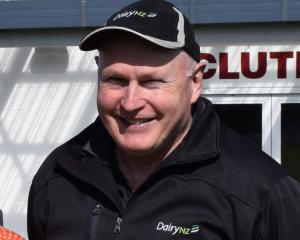

Mr Bixley and his wife Maree milk about 340 mixed-age Holstein Friesian cows on their 142ha farm and 28ha support block in Tussock Creek, about 20km north of Invercargill.
The major shareholders of the farm are his parents Russell and Lynda, who live in Auckland.
The Bixleys moved to Southland from the Waikato to dairy farm about seven years ago and their cows spent their first few winters off farm.
Deciding to winter their own cows outside on baleage, they slightly reduced their herd size.
However, the farm could be wet, lacked shelter and had no feed pad.
His cows were big and needed plenty of feed, which could be challenging when conditions were muddy.
After back-to-back wet calvings, he called his father to tell him he would prefer farming in a drier part of New Zealand, such as Canterbury, he said.
"I called my dad and said I’m out."
He wanted his father, who is an accountant, to invest in a barn able to be used as a feed pad and extend the lactation of the cows in autumn.
A contract for a SmartShelters barn, 85m long and 22m wide with a canvas roof, was signed on November 2021.
The first cows to enter the barn were 200 early calvers on August 10 last year.

Cows stood in the feed lanes when the compost material was aerated down to 800mm twice a day.
All of the herd were put in the barn when it snowed for three days in October last year.
"We only lost production for one day through the snow, which was quite good."
The heifers were put in the barn on May 10 this year.
When the weather turned a week later, the rest of the herd was put inside for three nights, which "stressed the bed", causing the composting process to cool and slow down.

He had considered moving some of the herd out of the barn to help improve the composting process.
"The cows were so comfortable and happy that it become too much effort to get them in the paddock, so we left them in there."
The barn was designed to compost when about 190 heifers and lighter mixed-age cows were inside.
Although the composting material could be in better condition, the cows were happier inside the barn than outside it.
"You come here at 8am and these girls are still asleep and all the cows outside are awake and ready to go."

He hoped introducing new shavings would improve composting in the barn.
Sometime in spring, the barn would have the compost removed for spreading on grass paddocks after they had been grazed on.
New composting material would be introduced to the shed.
If it got hot this summer, the cows would be put in the barn to reduce heat stress.
Before the barn was built, the weather dictated when the cows were dried off.

Calving this season begins on August 21.
Consequently, some cows could be dry for up to 90 days.
"It’s not the most economical system in the world."
They selected a SmartShelters barn because they felt it provided the most options for farming.
"We can calve in it, we can milk in it and we can dry cows in it."

He read research from Prof Keith Woodword about composting barns in New Zealand and abroad and said there was a lot to learn.
Sawdust seemed to be preferable composting material but it was harder to get than shavings.
Consents had been approved to build a second SmartShelters barn near the existing barn.
"We have four years to build that one."
The first barn was built in winter and more than 4000 tonnes of rock was required.

The build would include a weeping wall effluent system to serve both barns.
In hindsight, he would have built the first barn bigger, probably 2m wider, because it would not have cost much more and provided him more "freedom" to farm.
In the barn, the cows were fed 15kg of dry matter a day — a mix of 12kg baleage, 2kg rye straw and 1kg potatoes.
The potatoes contained starch and energy, which increased milk production, but accessing a consistent spud supply could be "a bit of a pain".
Benefits of the barn included healthier cows, which produced milk for more days.

The biggest driver for building the barn was to preserve their "sanity" when spring was wet.
Mrs Bixley agreed.
Having a barn allowed them to sleep when rain hit their roof in calving, rather than them staying awake to save calves, she said.
"Now I don’t have to stand a calf, or warm a calf.
"They’re 100% ready to go and their mums are happier."














